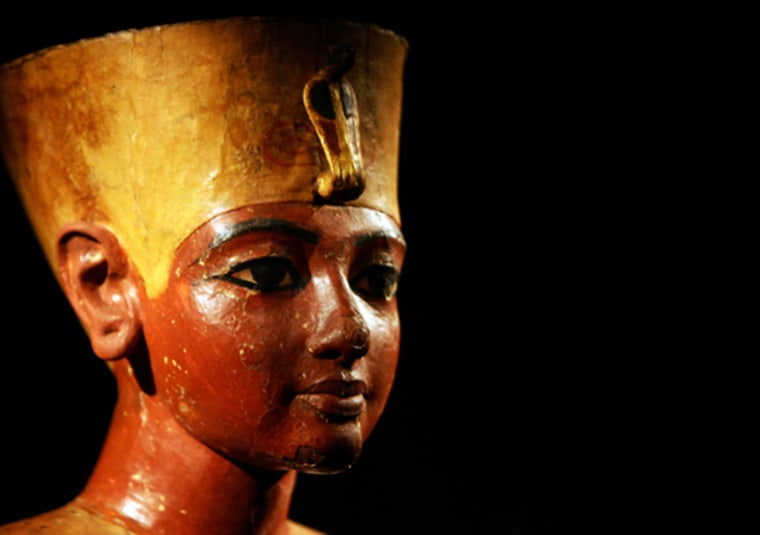An inscribed limestone block might have solved one of history's greatest mysteries — who fathered the boy pharaoh King Tut.
"We can now say that Tutankhamun was the child of Akhenaten," Zahi Hawass, chief of Egypt's Supreme Council of Antiquities, told Discovery News.
The finding offers evidence against another leading theory that King Tut was sired by the minor king Smenkhkare.
Hawass discovered the missing part of a broken limestone block a few months ago in a storeroom at el Ashmunein, a village on the west bank of the Nile some 150 miles south of Cairo.
Once reassembled, the slab has become "an accurate piece of evidence that proves Tut lived in el Amarna with Akhenaten and he married his wife, Ankhesenamun," while living in el Amarna, Hawass said.
The text also suggests that the young Tutankhamun married his father's daughter — his half sister.
"The block shows the young Tutankhamun and his wife, Ankhesenamun, seated together. The text identifies Tutankhamun as the 'king's son of his body, Tutankhaten,' and his wife as the 'king's daughter of his body, Ankhesenaten,'" Hawass said.
"We know that the only king to whom the text could refer as the father of both children is Akhenaten, himself. We know from other sources that Ankhesenamun was the daughter of Akhenaten and Nefertiti. Now, because of this block, we can say that Tutankhamun was the child of Akhenaten as well," Hawass said.
Found among other sandstone slabs in the storeroom of El Ashmunein's archaeological site, the block was used in the construction of the temple of Thoth during the reign of Ramesses II, who ruled around 1279-1213 B.C.
But the block wasn't freshly cut by the workers of the temple. Instead, it was recycled and brought there from el Amarna, along with some other thousand blocks, originally used to build the Amarna temples.
Now known as el Amarna, the city was once called Akhetaten after the "heretic" pharaoh Akhenaten (1353-1336 B.C.) had established the capital of his kingdom, introducing a monotheistic religion that overthrew the pantheon of the gods to worship the sun god Aton.
When Akhenaten died, a state decree was issued to purposefully destroy Amarna, and its building materials were distributed for use elsewhere.
According to Hawass, the block comes from the temple of Aton in Amarna and the forms of the inscribed names clearly date it to the reign of Akhenaten.
The best-known pharaoh of ancient Egypt, King Tut has been puzzling scientists ever since his mummy- and treasure-packed tomb was discovered in 1922 the Valley of the Kings by British archaeologist Howard Carter.
Only a few facts about his life are known.
While he lived in el Amarna, his name was Tutankhaton ("honoring Aton" — the sun god).
When he ascended the throne in 1333 B.C., at the age of nine, and moved to Thebes, he changed his name to Tutankamun ("honoring Amun" — a traditional cult).
As the last male in the family, his death in 1325 B.C. at age 19 ended the 18th dynasty — probably the greatest of the Egyptian royal families — and gave way to military rulers.
Mapping out the lineage of the Egyptian pharaohs is one of Hawass's latest challenges. King Tut has been either credited to be the son of Akhenaten or the offspring of Amenhotep III, who was Akhenaten's father.
Doubts also remain about King Tut's mother. Scholars have long debated whether he is the son of Kiya, Akhenaten's minor wife, or Queen Nefertiti, Akhenaten's other wife.
Egyptian researchers are currently carrying out DNA testing on two mummified fetuses found in King Tut's tomb, believed to be his offspring.
"If the fetus DNA matches King Tut's DNA and Ankhesenamun's DNA, then we would know that they shared the same mother," Hawass said.
According to Swiss anatomist and paleopathologist Frank Ruhli, head of the Swiss Mummy Project at the University of Zurich, Hawass' finding is very important.
"It supports one of my favorite theories about King Tut's parentage. DNA of proven relatives would help if it matches with the one of King Tut," Ruhli told Discovery News.
